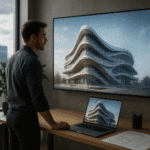Transparent architecture, characterized by the extensive use of glass, is revolutionizing the way we perceive and interact with our built environment. As cities grow and technology advances, architects are increasingly turning to glass to create structures that are not only aesthetically pleasing but also environmentally sustainable and functionally versatile. This article explores the evolution of glass buildings, examining the technological innovations and design philosophies that are shaping the future of transparent architecture.
The Rise of Glass in Modern Architecture
The use of glass in architecture is not a new phenomenon. Historically, glass has been employed in buildings for its ability to allow natural light to penetrate interior spaces, creating a sense of openness and connection with the outside world. However, it was not until the 20th century that glass truly began to dominate architectural design. The advent of modernist architecture, with its emphasis on minimalism and functionality, saw glass emerge as a key material in the construction of iconic structures such as the Farnsworth House by Mies van der Rohe and the Glass House by Philip Johnson.
In recent decades, the development of new glass technologies has further expanded the possibilities for its use in architecture. Innovations such as double-glazing, low-emissivity coatings, and smart glass have improved the energy efficiency and performance of glass buildings, making them more viable in a variety of climates and contexts. These advancements have allowed architects to push the boundaries of design, creating structures that are not only visually striking but also environmentally responsible.
Technological Innovations in Glass Architecture
One of the most significant technological advancements in glass architecture is the development of smart glass. This innovative material can change its properties in response to external stimuli, such as light or temperature, allowing for dynamic control of a building’s internal environment. Smart glass can reduce the need for artificial lighting and air conditioning, significantly lowering a building’s energy consumption and carbon footprint.
Another important innovation is the use of structural glass, which allows for the creation of large, uninterrupted glass surfaces without the need for traditional framing. This has enabled architects to design buildings with seamless, transparent facades that blur the boundaries between interior and exterior spaces. Structural glass is often used in conjunction with other advanced materials, such as carbon fiber and high-strength steel, to create lightweight yet robust structures that can withstand the demands of modern urban environments.
Design Philosophies and Environmental Considerations
The evolution of glass architecture is not solely driven by technological advancements; it is also shaped by changing design philosophies and a growing awareness of environmental issues. As architects seek to create buildings that are both beautiful and sustainable, glass has emerged as a material that can help achieve these goals.
One of the key design philosophies influencing the use of glass in architecture is biophilic design, which emphasizes the integration of natural elements into the built environment. By using glass to create transparent and open spaces, architects can foster a sense of connection with nature, enhancing the well-being of building occupants. This approach is particularly evident in the design of office buildings and public spaces, where access to natural light and views of the outdoors can improve productivity and reduce stress.
Sustainability and Energy Efficiency
As concerns about climate change and resource depletion grow, the sustainability of glass buildings has become a critical consideration for architects and developers. While glass is often criticized for its poor thermal performance, advancements in glazing technology have significantly improved its energy efficiency. High-performance glass can now provide excellent insulation, reducing the need for heating and cooling and minimizing a building’s environmental impact.
In addition to improving the energy efficiency of individual buildings, glass architecture can also contribute to broader sustainability goals. For example, the use of glass in urban planning can help create more walkable and livable cities by promoting natural light and ventilation, reducing the urban heat island effect, and enhancing the aesthetic appeal of public spaces.
The Future of Transparent Architecture
As we look to the future, the role of glass in architecture is likely to continue evolving in response to new challenges and opportunities. Emerging technologies, such as 3D printing and nanotechnology, hold the potential to further transform the capabilities of glass, enabling the creation of even more innovative and sustainable structures.
Moreover, as the world becomes increasingly urbanized, the demand for transparent architecture is expected to grow. Glass buildings offer a solution to the challenges of urban density, providing light-filled, flexible spaces that can adapt to the changing needs of cities and their inhabitants. As architects and designers continue to explore the possibilities of glass, we can expect to see a new generation of buildings that redefine the relationship between people and their environment.
In conclusion, the evolution of glass architecture is a testament to the power of innovation and creativity in shaping the future of our built environment. By embracing the potential of transparent materials, architects are not only creating visually stunning structures but also paving the way for a more sustainable and harmonious world.










